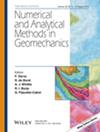A Novel Three‐Dimensional Analytical Model for the Thermomechanical Responses of Energy Piles and the Surrounding Soil Based on Thermoelastic Theory
IF 3.4
2区 工程技术
Q2 ENGINEERING, GEOLOGICAL
International Journal for Numerical and Analytical Methods in Geomechanics
Pub Date : 2025-05-27
DOI:10.1002/nag.4010
引用次数: 0
Abstract
Owing to their dual role in utilizing geothermal energy and supporting structural loads, energy piles are affected by thermomechanical loads. Moreover, the heating/cooling of energy piles also causes non‐negligible thermal stresses in the soil around the piles. The load transfer method is commonly used to address the thermomechanical response of energy piles. However, this method has problems such as slow convergence speed, difficulty in determining parameters and neglect of the soil coupling effect. Additionally, the method is unable to be used for analysing the thermal stress and strain of the soil around the piles. To overcome the limitations of the load transfer method, in this paper, a novel three‐dimensional analytical model based on thermoelastic theory that couples the thermomechanical coupling effect between energy piles and soil is proposed. The governing equations are derived in axisymmetric coordinates, and solutions to the heat diffusion equation are applied. The Helmholtz equation is solved with undetermined coefficients determined by boundary conditions via separation of variables and recurrence relations of modified Bessel functions. By comparing the results with those of field and centrifuge tests, the solution's validity is verified. Unlike discrete load transfer methods, the continuum mechanics‐based framework eliminates iterative convergence issues and quantitatively evaluates soil thermal stress and displacement. The proposed model provides a theoretical tool for refined energy pile design under mixed geological and thermal boundary conditions, advancing multiphysical field coupling analysis for geothermal structures.基于热弹性理论的能量桩及其周围土体热力学响应三维解析模型
由于能源桩具有利用地热能和支撑结构荷载的双重作用,因此受到热力载荷的影响。此外,能源桩的加热/冷却也会在桩周围的土壤中产生不可忽略的热应力。荷载传递法是求解能源桩热力学响应的常用方法。但该方法存在收敛速度慢、参数确定困难、忽略土壤耦合效应等问题。此外,该方法不能用于分析桩周土体的热应力和热应变。为了克服荷载传递方法的局限性,本文提出了一种新的基于热弹性理论的三维解析模型,该模型将能量桩与土之间的热力耦合效应耦合起来。在轴对称坐标系下推导了控制方程,并对热扩散方程进行了求解。通过分离变量和修正贝塞尔函数的递推关系,求解了边界条件下待定系数的亥姆霍兹方程。通过与现场和离心机试验结果的比较,验证了该方案的有效性。与离散荷载传递方法不同,基于连续介质力学的框架消除了迭代收敛问题,并定量评估了土壤热应力和位移。该模型为地热混合边界条件下的精细化能源桩设计提供了理论工具,推进了地热构造的多物性场耦合分析。
本文章由计算机程序翻译,如有差异,请以英文原文为准。
求助全文
约1分钟内获得全文
求助全文
来源期刊
CiteScore
6.40
自引率
12.50%
发文量
160
审稿时长
9 months
期刊介绍:
The journal welcomes manuscripts that substantially contribute to the understanding of the complex mechanical behaviour of geomaterials (soils, rocks, concrete, ice, snow, and powders), through innovative experimental techniques, and/or through the development of novel numerical or hybrid experimental/numerical modelling concepts in geomechanics. Topics of interest include instabilities and localization, interface and surface phenomena, fracture and failure, multi-physics and other time-dependent phenomena, micromechanics and multi-scale methods, and inverse analysis and stochastic methods. Papers related to energy and environmental issues are particularly welcome. The illustration of the proposed methods and techniques to engineering problems is encouraged. However, manuscripts dealing with applications of existing methods, or proposing incremental improvements to existing methods – in particular marginal extensions of existing analytical solutions or numerical methods – will not be considered for review.

 求助内容:
求助内容: 应助结果提醒方式:
应助结果提醒方式:


